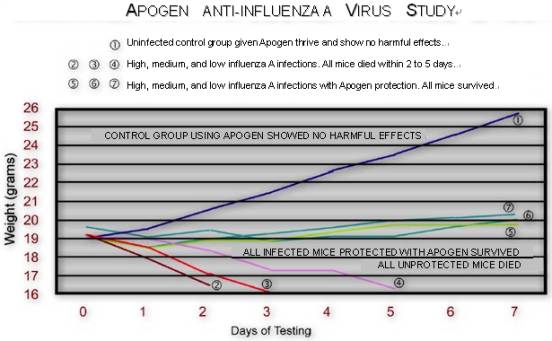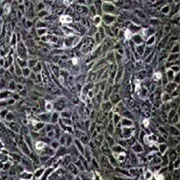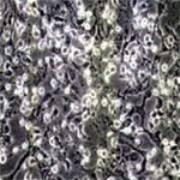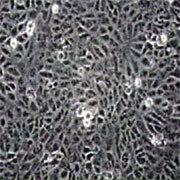|
Apogen
GVP is not a drug. It’s a patented nutritional supplement
concentrated and purified from proprietary strain FEM-101
and organically grown spirulina, a healthful bluegreen algae
so rich in nutrients it’s commonly called a superfood. It
takes the equivalent of 450 tablets of spirulina to make one
serving of Apogen GVP, or more than 13,000 tablets to make a
single box!
Apogen
GVP does not kill viruses. Instead, it protects cells by
creating a "viral firewall" that many viruses
can’t cross. While Apogen GVP is not intended to treat or
prevent illness, just like vitamins, minerals and other
nutritional supplements, Apogen GVP’s scientifically
demonstrated action helps support the body’s natural
defenses.
In
addition different types of flu virus, Apogen GVP has also
been shown to inhibit a number of other pathogens including
several potentially serious intestinal viruses (Enterovirus
71 and Coxsackie virus A162) that may cause illness,
paralysis and even death, especially in children. Additional
research is currently underway to explore Apogen GVP’s
range and mechanisms of action.
Apogen®
— Safety and Effectiveness
Recently,
scientists at National Chang Gung University in Taiwan
compared the relative effectiveness of Apogen and the most popular prescription drug for treating type A
influenza, including the current H5N1 "bird flu."
Unlike
the popular prescription drug, which is a pharmaceutical drug that works to
disable an essential part of a type A influenza virus’s
structure, Apogen is a food-based, organic nutrient complex
that works to protect cells from penetration by the virus.
In
this study, the scientists determined the amount of
Apogen needed to block 50% of the spread of the virus in a
cell culture. The numerical results, called IC50 — short
for inhibitory concentration 50% — showed that it took
12.3 times less Apogen to achieve the same virus inhibiting
effects as the popular drug.
The
study also determined the relative cellular toxicity of
Apogen, determining how high a concentration is
required to kill 50% of the cells. This factor, called LC50
— short for lethal concentration 50% — was more than 3
times better for Apogen than the popular drug. This means that cells can
tolerate much higher amount of Apogen than the popular drug, even
though much less is required to be effective.
Putting
these two numbers together determines the "safety
margin" — a measure of how many times the effective
concentration it takes to produce a toxic reaction. Larger
numbers are better. In this experiment with a virulent type
A influenza, the safety margin for the popular drug was 72, while for
Apogen it was more than 2800!
|
|
EFFECTIVENESS
IC50
Lower is better
|
TOXICITY
LC50
Higher is better
|
SAFETY
MARGIN
LC50 to IC50 ratio
Higher is better
|
|
Popular
Prescription Drug
|
0.173
|
12.50
|
72
|
|
Apogen
|
0.014
|
39.46
|
2818
|
As
these results clearly demonstrate, Apogen was 12.3 times
more effective at inhibiting the spread of viral plaque than
the popular drug and more than 3 times less toxic to the experimental
cells, providing a safety margin almost 40 times better.
Live
Mice Study
Groups
of mice were exposed to 3 different levels of an extremely
pathogenic type A influenza virus. Half of the mice in each
group were orally administered a small dose of Apogen once
per day, starting 6 hours after viral exposure. Researchers
tracked body weight and mortality for all groups versus a
control population fed Apogen but not exposed to the virus.

Results:
All unprotected animals died within 2 to 5 days of viral
exposure, at a rate proportional to their viral load. All
animals protected with Apogen survived, independent of the
their viral load. In other words, while the mice with even
the smallest viral load all died from their influenza
exposure, all mice protected with Apogen survived – even
those exposed to 100 times more virus.
Apogen®
GVP
Cell
Culture Studies
Cell
cultures tests were performed using standard MDCK cells
exposed to Enterovirus-71, a potentially lethal intestinal
virus. The first photo shows normal, uninfected cells seen
through the microscope. The second picture shows the type of
cytopathic damage that occurs when virus particles enter
cells and replicate. The last picture shows how cells
exposed to the same level of virus are protected when Apogen
is present. No viral cytopathic damage is observed and cells
continue to function normally.
|

|

|

|
|
Healthy
cells, not exposed to viral infection, show normal
structure and function
|
Identical
cells exposed to Enterovirus-71 show extensive
structural & functional damage
|
Cells
exposed to viral infection but protected with Apogen
exhibit no cytopathic effects
|
All
studies conducted at the School of Medical Technology of
National Chang Gung University in Taiwan
1.
In an independent scientific study of highly pathogenic
influenza virus type A/WSN/H1N1 conducted at School of
Medical Technology of Chang Gung University , Taiwan.
2.
Shih SR, Tsai KN, Li YS, Chueh CC, Chan EC. “Inhibition of
Enterovirus 71-Induced Apoptosis by Allophycocyanin Isolated
From a Blue-Green Alga Spirulina platensis,” Journal of
Medical Virology. 2003; 70: 119-125. DOWNLOAD FILE (PDF)
|